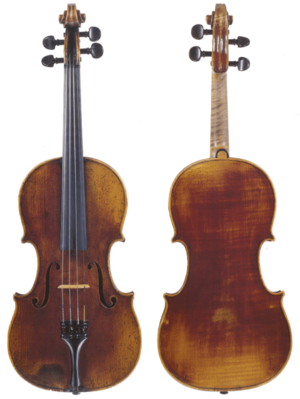William Ringwood facts for kids
Quick facts for kids
William Ringwood
|
|
|---|---|
| Uilliam Ringwood | |

Violin by Ringwood, around 1800
|
|
| Born | c. 1769 Dublin, Ireland
|
| Died | c. 1842 Dublin, Ireland
|
| Nationality | Irish |
| Education | Thomas Perry |
| Known for | Luthier |
| Style | Amati style |
| Movement | Irish school |
William Ringwood (whose name in Irish is Uilliam Ringwood) was an Irish luthier and music teacher from Dublin. A luthier is someone who makes or repairs string instruments like violins. William Ringwood lived from about 1769 to 1842.
Contents
Early Life of William Ringwood
We do not know much about William Ringwood's early life. Experts believe he was born around 1769, probably near Dublin. This guess is based on when he started learning to make violins. Some records suggest he might have been born a bit later, around 1771. This is because he was still listed as an apprentice in documents from 1793.
William Ringwood's Career as a Luthier
Learning to Make Violins: 1783–1793
William Ringwood started his journey as a luthier in Dublin in the early 1780s. He became an apprentice to a famous violin maker named Thomas Perry. Perry's workshop was at 6 Anglesea Street. Ringwood trained there between 1783 and 1790.
He learned his skills alongside other talented apprentices. These included Richard Tobin and William Wilkinson, who was Perry's nephew. Much of what we know about Ringwood's time with Perry comes from official records.
For example, in 1785, Thomas Perry renewed the lease for his workshop. Ringwood signed the document as a witness. The record called him "apprentice to Thomas Perry." In 1789, Perry teamed up with his nephew, Wilkinson. Their business then became 'Perry & Wilkinson'.
In 1793, Perry renewed his lease again. Ringwood was still listed as a witness and an apprentice. This makes some people wonder if he started his training later, or if it took him longer than the usual seven years to finish.
Working with the Perry Firm: 1793–1818
After finishing his apprenticeship, Ringwood continued to work with the Perry firm. He stayed at Anglesea Street until Thomas Perry passed away in 1818. During these years, Ringwood worked with other skilled luthiers.
These included John Delany, who joined in 1796, and John Mackintosh, who started in 1808. Ringwood also worked with a famous Italian luthier, Vincenzo Panormo. Panormo came to Dublin in 1799 and spent a few years making instruments for Perry.
Ringwood is thought to have had a son named Arthur. Arthur was born around 1812 and also became a violin maker. William Ringwood was a witness to Thomas Perry's last will. He signed it on June 7, 1818. Thomas Perry died in November of that same year.
Starting His Own Business: 1818–1842
After Perry's death, Ringwood started a business with another maker, John Wheatley. They had a successful business buying and selling instruments. They hired several assistants to help them make instruments. This partnership might have ended around 1825.
Records show that Ringwood also worked as a music teacher in Waterford around 1824. Later, he worked as a luthier on his own. He lived and worked at different addresses in Dublin. These included 150 Abbey Street (in 1830 and 1831), 27 Mary Street (in 1832), and 14 Fownes Street (in 1842). He likely continued making and selling instruments until his death around 1842.
William Ringwood's Style and Techniques
It is hard to know exactly how good Ringwood was as an individual maker. This is because he spent most of his career working for Thomas Perry's firms. However, the instruments that are clearly made by Ringwood are considered "very fine." He is seen as "one of Perry's most talented apprentices."
Ringwood's later instruments look similar to those made by Nicola Amati. Amati was a famous Italian luthier whose violins greatly influenced the Irish school of violin making. Ringwood might have studied an Amati instrument directly. It is believed that his mentor, Perry, borrowed one from the Duke of Leinster. Ringwood might also have been influenced by Panormo's style, which was also similar to Amati's. Panormo also made instruments for the Duke of Leinster while in Dublin.
|
|||||||||||||||||||||||||||||||||||||||||||||||||||||||||||||||||||||||||||||||||||||||||||||||||||||||||||||||||||||||||||||||||||||||||||||||||||||||||||||||||||||||||||||||||||||||||||||||||||||||||||||||||||||||||||||||||||||||||||||||||||||||||||||||||||||||||||||||||||||||||||||||||||||||||||||||||||||||||||||||||||||||||||||||||||||||||||||||||||||||||||||||||||||||||||||||||||||||||||||||||||||||||||||||||||||||||||||||||||||||||||||||||||||||||||||||||||||||||||||||||||||||||||||||||||||||||||||||||||
|
|||||||||||||||||||||||||||||||||||||||||||||||||||||||||||||||||||||||||||||||||||||||||||||||||||||||||||||||||||||||||||||||||||||||||||||||||||||||||||||||||||||||||||||||||||||||||||||||||||||||||||||||||||||||||||||||||||||||||||||||||||||||||||||||||||||||||||||||||||||||||||||||||||||||||||||||||||||||||||||||||||||||||||||||||||||||||||||||||||||||||||||||||||||||||||||||||||||||||||||||||||||||||||||||||||||||||||||||||||||||||||||||||||||||||||||||||||||||||||||||||||||||||||||||||||||||||||||||||||
Instruments Made by Ringwood
We do not know how many instruments William Ringwood made during his life. His name sometimes appears on instruments made by Perry's firm. His later instruments were probably made with the help of his assistants. An excellent red-varnished violin made by Ringwood was played for many years by Irish violinist Thérèse Timoney.
Here are some known instruments made by William Ringwood:
- Around 1800: A violin from Dublin, sold by Tarisio.
- Unknown date: A violin from Dublin, once owned by William Hofmann. Thérèse Timoney used this violin in the 1970s.
See also
- John Delany (luthier)
- John Mackintosh (luthier)
- Vincenzo Panormo
- Thomas Perry (luthier)
- Richard Tobin (luthier)
Images for kids


